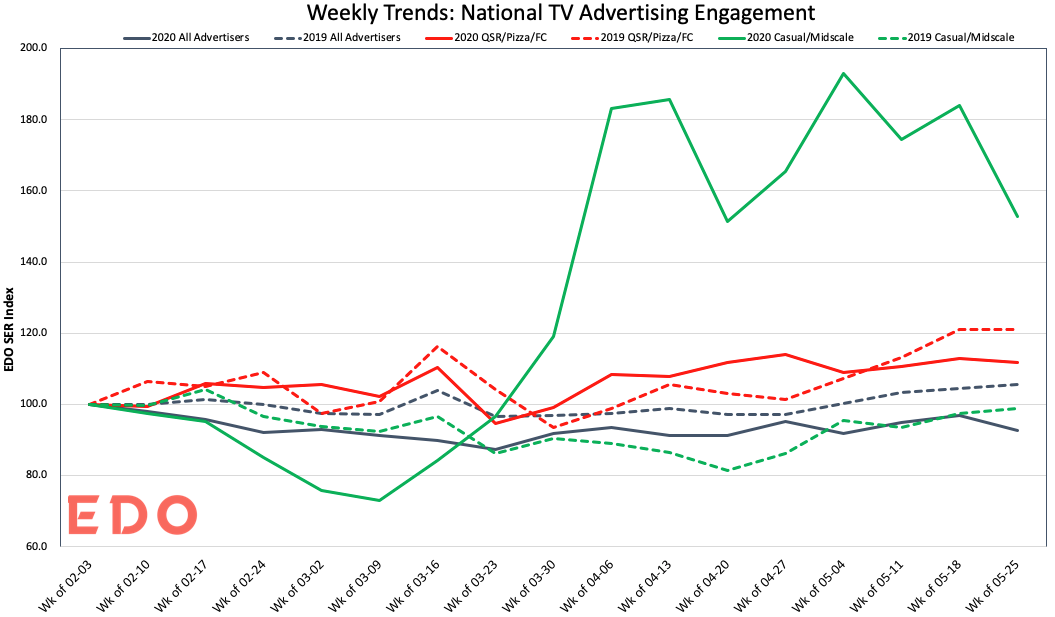Over the last few months, we have all watched the TV advertising industry endure massive disruptions. Marketers who quickly adapted their creative messages by expressing empathy while offering hope and understanding in the form of relevant solutions produced favorable engagement from consumers. And while quantifying the long-term impact this will generate for these brands takes time, our real-time leading indicator suggests that better days are ahead.
EDO prepared the following report to provide you a data-driven perspective on COVID-19’s impact on national linear TV restaurant advertising.
Consumer Response to TV Advertising
EDO data indicates that consumer response to TV ads declined from late February to its lowest point in late March and has seen a resurgence in April and May across all advertisers.


The chart above tracks the collective weekly TV ad performance for Restaurant advertisers and all advertisers using EDO’s proprietary Search Engagement Rate (SER) metric. SER measures the incremental online search activity generated for the brand in the minutes immediately following a TV ad airing. It controls for both audience size and ad duration to enable an apples-to-apples comparison of the effectiveness of each brand’s TV campaign.
-
QSR/Pizza/Fast Casual SER performance recovered by 18% since its lowest point during the week of March 23rd. The category continues to have a diverse set of advertisers with a strong TV presence, accounting for almost 10% of all national TV impressions.
-
Casual Dining/Midscale continues to effectively engage consumers with a SER score 109% higher than the week of March 9th, its lowest point over our measurement period. The category currently only makes up 0.3% of all national TV impressions
COVID-19 Creative by Brand
The majority of restaurant brands have a COVID-related spot outperforming their respective 12-month brand average benchmark, indicating the effectiveness of communicating relevant messaging during times of crisis.
-
KFC promoted its free delivery and open drive-thru in the nostalgic Sunday Dinner spot, poking fun at Sunday dinners which they say are suitable for “every day” because “we aren’t keeping track of days anyhow”.
-
Sonic Drive-In continued to effectively advertise the Red Bull Slushes spot, which resulted in a SER score 35% higher than its 12-month benchmark.
-
Arby’s brilliantly recycled an old commercial with the Pecan Chicken Sandwich spot, outperforming its 12-month benchmark by 12%.
-
Olive Garden continues to lead the category and effectively engage with TV viewers with its Buy One, Take One To Go spot, outperforming its 12-month benchmark by 125%.
Media Programming Changes
EDO observed changes in restaurant TV advertisers’ media plans by Network Type, Language, Daypart, and Program Type pre- and post-COVID-19, using March 16 as the demarcation line.
The pre-period covers the six-week period from February 2 through March 15, while the post-period covers the last eleven weeks from March 16 through May 31.
Highlights:
-
Overall, Broadcast Networks saw a decrease in spend from both QSR/Pizza/FC (-23%) and Casual Dining/Midscale (-42%). Spanish Language TV also experienced a pullback in impressions from QSR/Pizza/FC (-15%) and Casual Dining/Midscale (-11%).
-
QSR/Pizza/FC heavily increased its presence on news (+56%) while slightly increasing impressions during movie (+14%) and non-live sports (+18%) programming.
-
On the other hand, Casual Dining/Midscale heavily increased investment in movie programming (+49%) and decreased spending on non-live sports programming (-45%).

